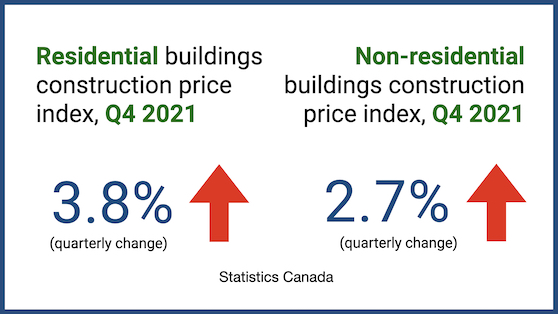
Business
Features
News
Still rising – Building construction price indexes Q4 2021
February 18, 2022 | By Anthony Capkun

February 18, 2022 – Nationally, residential building construction costs increased 3.8% in Q4 2021, Statscan reports, following a similar rise in Q3. Non-residential building construction costs were up 2.7% in Q4, dropping slightly from the previous quarter.
Costs to construct residential buildings increased the most in Montreal, followed by Toronto and Vancouver. In Q4, the cost to build low-rise apartments grew the most out of all of the buildings in scope for the survey in both Montreal and Vancouver, while single-detached houses led the growth in Toronto.
Moncton experienced the smallest quarterly price increase in the cost of construction of residential buildings, followed by Saskatoon and Ottawa.
Non-residential building construction costs rose the most in Ottawa, Toronto and Edmonton. However, for both Ottawa and Toronto, the quarterly growth “decelerated” compared to the previous quarter, says Statscan.
While growth in non-residential building construction prices across some of the census metropolitan areas (CMAs) surveyed slowed in Q4, Saskatoon recorded its highest quarterly price growth of the year. The cost of building bus depots with maintenance and repair facilities, as well as factories, increased the most in this CMA.
Wood, plastics and composites continued to be the largest contributor to the price increase in residential building construction. Softwood lumber prices rose again in October and November, but not enough to offset the large decrease observed from May to August.
Despite this uptick, contractors reported a slower increase rate in the prices of wood products, compared with Q3, with some noting a decline in prices. This was offset by stronger price growth for other important residential construction inputs, including finishes (e.g. drywall, paint), windows and doors, as well as thermal and moisture protection elements.
Increases in the costs to construct non-residential buildings was mostly driven by a rise in prices for metal fabrication products and concrete elements (including steel reinforcement). Contractors mainly attributed the higher costs to rising labour costs resulting from skilled labour shortages and rises in the price of steel products, which was impacted by supply constraints.
Building construction costs for residential construction in the 11-city composite rose 21.7% year-over-year in Q4, surpassing the previous high registered in the third quarter. The largest increases were in Calgary, Toronto, Edmonton and Ottawa.
Non-residential construction building costs rose 11.2% year-over-year in Q4, which was the largest increase since the third quarter of 2008. Construction costs increases were the largest in Ottawa, Toronto and Edmonton, with both Ottawa and Toronto recording new year-over-year highs in Q4.
The pandemic continued to have an impact on the construction sector, notes Statscan, as contractors once again cited that increases in labour costs and in building material prices were still pushing up their costs. This led to record yearly price increases for both residential and non-residential building construction costs.
The number of building permits and permit values were up for both the residential and non-residential sector in 2021 compared with 2020, further confirming the growth of the demand for labour and building materials. The increase in value of the building permits issued was also a factor driving the demand for heavily used construction materials, such as lumber and steel products. These materials have been impacted by supply chain issues throughout 2021 as a result of the pandemic.
Job vacancy rates in the Canadian construction industry increased at a faster rate in the second half of 2021 compared with the first half, showing a rise in the need for skilled labour during a time of growing demand. This put upward pressure on costs Canadian builders had to pay for labour.
In 2021, the 11-city composite for residential building construction costs rose 18.1%, which represents its largest annual increase since its inception in 2017.
Yearly construction costs for residential buildings rose the most for townhouses and single-detached houses (both up 22.5%) from 2020 to 2021.
Growth in the residential building construction costs in 2021 surpassed previous highs in every CMA surveyed. Cost increases hit double digits in all CMAs, except for Vancouver (+9.5%), showing the largest annual growth in Calgary and Ottawa.
The 11-city composite for non-residential construction cost increased 6.9% in 2021 compared with 2020. This was the highest yearly increase since 2008. Factories and bus depots with maintenance and repair facilities saw their construction costs rise the most on an annual basis.
Non-residential construction costs increased the most in Ottawa and Toronto, with Ottawa registering the largest annual growth since the beginning of the index in 1981.
Note: The cities that make up Statscan’s 11-City Composite are: St. John’s, Halifax, Moncton, Montreal, Ottawa, Toronto, Winnipeg, Saskatoon, Calgary, Edmonton, Vancouver.
Print this page